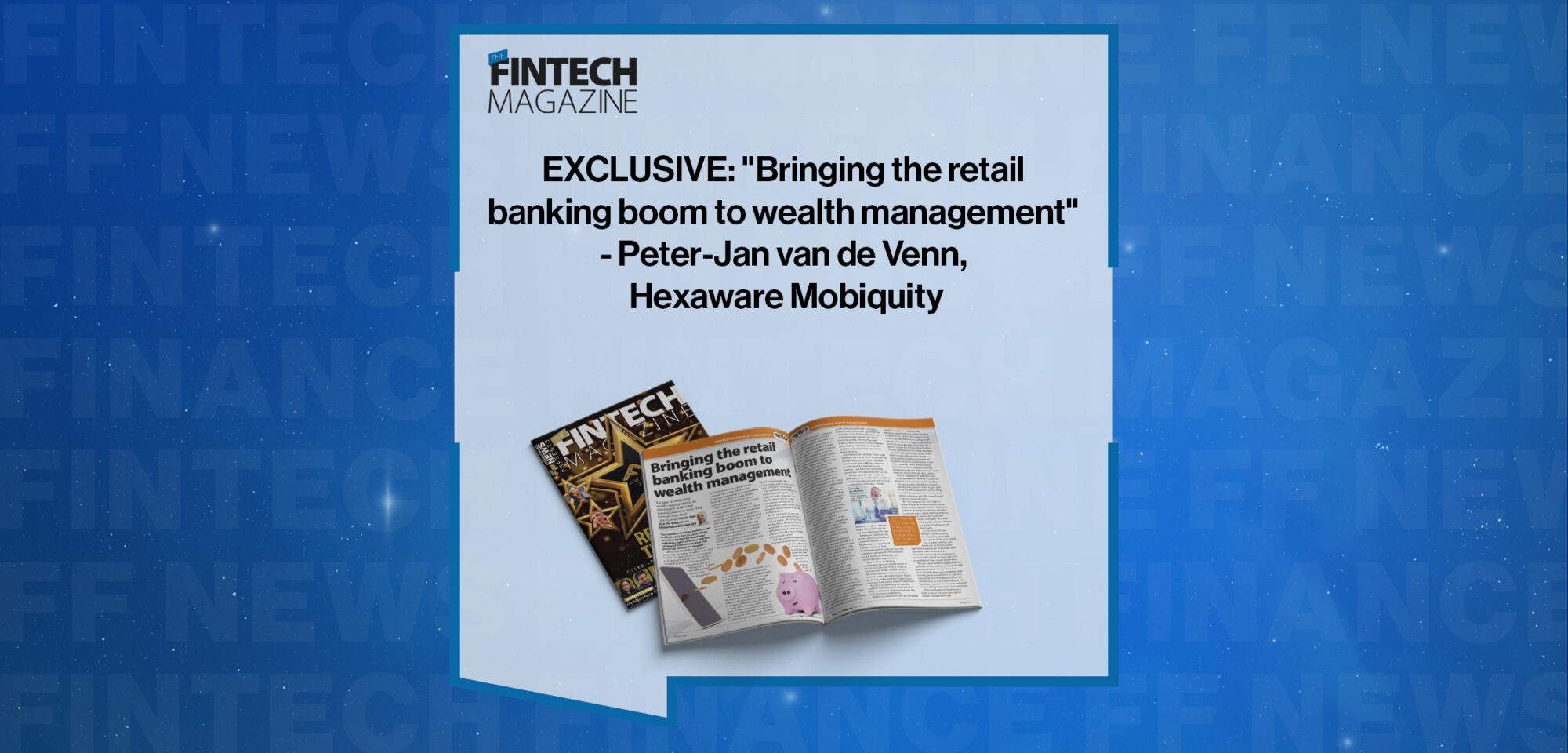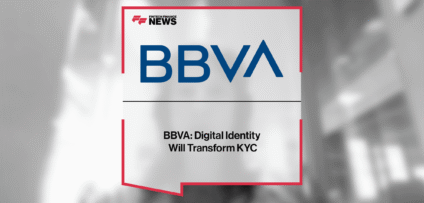Breaking News

EXCLUSIVE: “Bringing the retail banking boom to wealth management” – Peter-Jan van de Venn, Hexaware Mobiquity in ‘The Fintech Magazine’
It’s time to reimagine wealth management, as users enjoy continued transformation in how they interact with their money, says Peter-Jan van de Venn from Hexaware Mobiquity
The consumer banking environment in which many Gen Zs came of age was characterised by two things: exploding digital adoption and the collapse of interest rates that had shored up savings for decades.
Take the UK. Overall, the average UK interest rate for the last 50 years – from 1973 to 2023 – has been 9.1 per cent, according to the Bank of England. But in the 2010s, it struggled to reach one per cent and the lowest was 0.25 per cent.
During those 10 years, most areas of retail finance were fast migrating to mobile-first provision and high-touch customer interaction, led by young businesses challenging the way established banking institutions operated. Wealth management was behind the curve.
Then came the pandemic. It accelerated a handful of existing trends, namely investor preferences for lower-cost, passive strategies; the adoption of digital channels across generational divides; and advisory’s shift toward holistic financial planning and customised experiences. But it also meant wealth management firms and private banking for high net-worth individuals – which historically were the most highly personalised of all financial services – suddenly found themselves marooned from customers without the opportunity for face-to-face interaction.
Lower down the investment scale, savers who could see there was no value to be had from leaving savings on deposit, used lockdown to try their hand at ‘arm-chair’ investing – the so-called ‘Robinhood Generation’ who turned to that and other investment apps to try to maximise returns from money they couldn’t spend.
The trouble was that many, lacking the experience and knowledge that had traditionally been provided by wealth managers, suffered losses when the markets corrected after 2020. The total share of trading turnover attributed to retail investors last year returned to the pre-pandemic level of 12 per cent after surging as high as 20 per cent, according o ASX data in Australia – although micro-investing apps are still estimated to be a US$1trillion market globally.
The combination of shifts in these two wealth-chasing demographics – the traditional wealth management client and the self-serve investor – means any institution looking to own the transformation in advisory services now is faced with an increasingly diversified and complex audience.
But the opportunity for banks, who already have a relationship with both, of course, is evident… that’s if they get the strategy right. In the words of Peter-Jan van de Venn, VP of global digital banking at Hexaware Mobiquity, there has been a fundamental shift in who is looking to manage wealth and how.
“It all starts with the democratisation of access to investment services. It used to be for ultra-high-net-worth individuals, but, driven by technology and low interest rates, there’s need for investment and wealth management products in the mass market.
But, as in many other areas, so much of what is out there is depressingly similar.
“The life journey is way more important to look at than the product journey”
“It is still surprising to me that there is so much of the same brought to customers,” says van de Venn. “Differentiation is so key. We see it also in our retail banking research, where we found that 80 per cent of the features that banks bring to their customers are common. In wealth management, it’s even higher. There’s a lot of the same type of investments, the robo advice, etc.”
Hexaware Mobiquity’s Wealth Management Features Radar , the latest in a series of Banking Radar reports, aims to correct that. It highlights how banks can take advantage of what’s been dubbed elsewhere ‘Wealth Management 3.0’ – using tech-led innovations to imaginatively serve lower wealth segments at a profit, something that wasn’t feasible previously.
As with the company’s previous analyses, the conclusion is that providers shouldn’t reinvent the wheel, but use off-the-shelf solutions for the foundational services that customers expect, and invest money, time and effort in proprietary products and services that are uniquely designed for that bank’s target demographic.
“We see banks focussing a lot on the product, but a customer is not buying an investment; they want to retire, or they want to have a safe future for their children,” says van de Venn. “So the life journey is way more important to look at than the product journey.
“That could be achieved by having a more holistic view of wealth management – having an overview of a customer’s total net worth, not just what they have at the bank, or what they invest there. So really helping with financial planning in the longer term. These types of products and services are now also moving into the digital space on a feature level.”
Hexaware Mobiquity puts wealth management tools into three main categories: The Musts, The Delighters and The Differentiators. The Musts are defined as the features that every wealth management platform has to offer. The Delighters are features that are more of a rarity on the market, but are a feasible type of feature for wealth management platforms to offer in order to improve their customer experience beyond the bare bones. The Differentiators are the crème de la crème, the functions and features that can’t be commonly achieved – ambitious solutions that set a provider apart from the competition.
Each of these categories can be applied to eight areas of innovation: Client Onboarding, Financial Planning, Analytics, Advice and Interactions, Portfolio Setup, Trading and Investment, Portfolio Monitoring, Account Top-Up and Holistic Wealth Planning.
Beyond that, brand promise is also really important, says van de Venn. “Even with the same products, you can have a different view, you can serve a different segment, you can adjust the language to your segment… but have that consistently everywhere in the processes that you run.
“Sometimes, when I am in my own banking app, I can see that there is different technology on the back end when I move to another area of the app – it look different, or it takes a little bit longer. And this all hurts the customer experience,” he says.
Building an understanding of which products to build for customers comes from a fundamental re-imagining of customer relations – from understanding which products have the potential to generate the most income to what Hexaware Mobiquity calls ‘needs-based sub-segmentation’.
“When it comes to defining subsegments, we don’t think in terms of income, but rather we think in terms of, ‘what are their needs?’, because that is way more important,” says van de Venn. “A needs-based sub-segmentation allows you to truly understand the frictions your customers have in their daily financial lives.”
This focus on diversity and, crucially, customer-centric product offerings, while still in its infancy, is evidenced among the most innovative wealthtechs. Ellevest is a good example. The US-based wealth management platform was designed specifically with women in mind. In practice, this means taking into account obvious gender differences, such as longer expected lifespans and higher chances that they’ll be controlling finances without a partner in later life.
Women clearly value it; Ellevest currently has 3.3 million members. Another example is Zoya, which offers halal investing, designed to take the guesswork out of aligning investment decisions with faith-based beliefs. It also reflects another trend: the increasing demand for ESG and impact investing – allowing investors to make money in a way that sits comfortably with their values.
Wealth management platforms have not always been in a position to offer this flexibility. Technology has changed that. Forbes recently published a positively glowing endorsement of the impact of AI on the wealth management sector, citing its potential to reduce risk and cost, scale advisor efficiency and offer supercharged customer-personalisation.
But not everyone has the budget or desire to build all this provision in-house, which is often where Hexaware Mobiquity, comes in. It designs, builds and maintains customer centric digital banking solutions. In this model, banks and wealth managers can create cutting-edge solutions to cater to a range of customers and their needs.
At the end of the day, though, a bank’s strategy for extending any wealth management offer has to build into a viable business case, hence van de Venn’s caution against reinventing the technology wheel but rather banks leveraging the information they hold on customers to create an offer based on a well-informed knowledge of what would delight them.
“We see many neobanks popping up, very customer-centric, but they are not profitable,” says van de Venn. “So, my advice is to innovate only where you can differentiate. Don’t try to be too different on stuff that everybody has. Leverage out-of-the-box components as much as possible for your foundation layer, so there is more budget left for true differentiation and true innovation.
“Then you have the ingredients to build a successful bank, focussed on wealth management.”
This article was published in The Fintech Magazine Issue 30, Page 57-58
People In This Post
Companies In This Post
- How USAA Builds Digital Experiences Around Its Members Read more
- Spayce: Organic Growth, Own Tech, New Wallet Read more
- EXCLUSIVE: “Check, Check… and Check!” – Pilar Fragalà, CBI in ‘The Fintech Magazine’ Read more
- BBVA: Digital Identity Will Transform KYC Read more
- Pocket Network Is Pioneering ‘DePIN for Data’ Read more

















